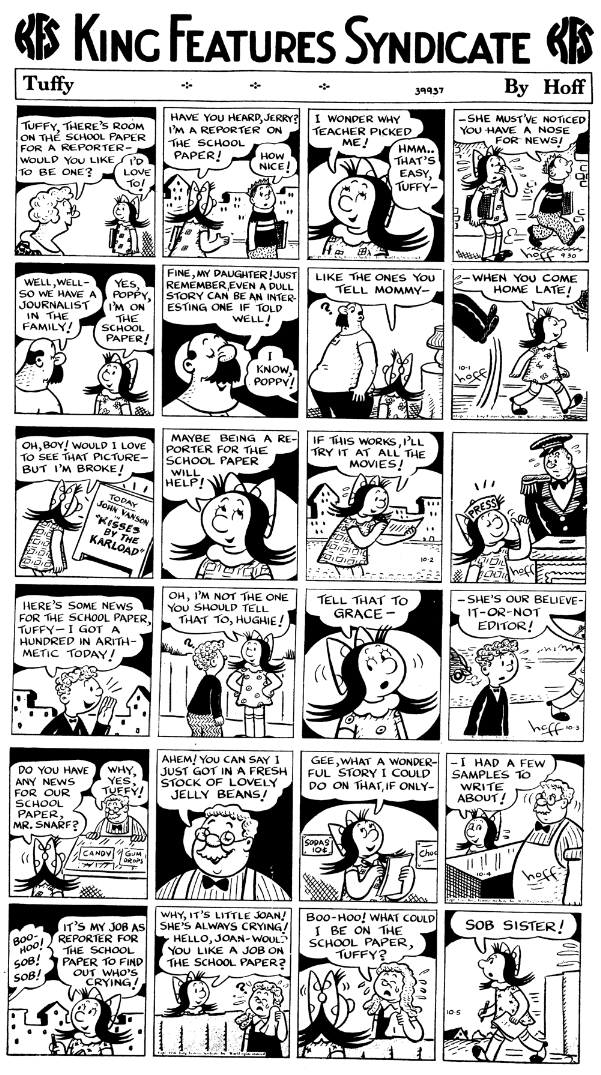
by Dina Weinstein
Zaftig Mamas, Tenement Toughs, Suburban Strivers: Syd Hoff’s Unapologetic Jewish Cartoon Women
I love that Jewish women abound in the artwork of children’s book author and cartoonist Syd Hoff. I was a fan of his classic “I Can Read” books in my Cold War-era childhood. But when I read the quirky stories to my sons I began to see a whole different message about gender that had escaped me in my own youth.
Hoff’s zaftig mama is everywhere in his made-in-Miami children’s books and the New Yorker cartoons he produced from 1929 to 1975—as are other archetypal female characters. There are young and innocent girls, tenement-dwelling street toughs, eligible maidens, sexy molls and buxom Bronx Jewish mothers. Hoff was portraying Jewish women realistically and unapologetically for a general readership.

The artist and author is most famous for the 1958 HarperCollins “I Can Read” book Danny and the Dinosaur. (Hoff bent to the times. In the 1970s age of equal opportunity he published Amy and the Dinosaur.) Now, on the 100th anniversary of King Features Syndicate, it is an occasion to remember Hoff’s two long-running cartoon strips: “Tuffy,” a four-frame strip which ran from 1939 to 1949 and “Laugh It Off,” a one-frame gag cartoon, which ran from 1950 to 1970.
Tuffy was a tough female tenement urchin. “Laugh It Off” was similar to Family Circus with its anecdotal, humorous, domestic scenes. Looked at as a whole, it becomes apparent that Hoff used this platform to explore and appreciate Jewish women as Jewish Americans were asserting themselves in general culture.

 Most of Hoff’s storybook characters are animals and underdogs. In his 1959 book Sammy the Seal, Sammy is unhappy at the zoo until he sees some children going to school. Sammy says: “I will go too.” It’s up in the air whether the teacher will let a seal stay in school. Hoff put his zaftig mama striding across the cover of Sammy the Seal!
Most of Hoff’s storybook characters are animals and underdogs. In his 1959 book Sammy the Seal, Sammy is unhappy at the zoo until he sees some children going to school. Sammy says: “I will go too.” It’s up in the air whether the teacher will let a seal stay in school. Hoff put his zaftig mama striding across the cover of Sammy the Seal!
Hoff’s are stories about quests for belonging, a classic theme of the minority Jewish experience. Search deeper and you will find images of Hoff’s family and neighbors from his childhood acting out that search for belonging.
Hoff (1912-2004) himself was born and raised in The Bronx. While an art school student, he sold his first cartoon to The New Yorker as the Great Depression hit. “Keep drawing those Bronx types,” his editor at The New Yorker told him. Hoff specialized in portrayals of working class tenement dwellers.
Hoff moved to Miami Beach with his wife and two daughters in the 1950s. To put together a centennial exhibition of Hoff a few years ago, I dug into archives at the University of Minnesota and the University of Southern Mississippi, where Hoff’s work is held. I had just moved to Miami from urban Chicago and I was struck by the opulence of Jewish life in my newly adopted tropical city. The Syd Hoff centennial project was a pleasant escape from the materialistic world I found myself in. In Hoff’s portrayal of early Jewish American life I found a welcoming world, albeit with its share of bickering and kvetching.
Boxes upon archival boxes house Hoff’s artwork for his dozens of children’s book titles and “Laugh It Off” cartoons. Most of the Tuffy strips are lost or were destroyed. Fingering through the classically trained cartoonist and author’s work history was like absorbing a visual depiction of Jewish history from tenement to suburbia.

While Hoff often put male characters front and center, his images are full of women—Jewish women. I felt affection for the zaftig tenement mamas, striving suburban Jews, street toughs, molls, and sexy love interests. Hoff’s images portrayed Jews’ working class, immigrant, striving past.

There was an earnest, striving sense to Hoff’s early women. They accepted their bare-bones tenement life even in the pages of The New Yorker. And in Hoff’s “The Ruling Clawss” one-frame gag cartoons on the pages of The New Masses, Hoff’s women march to bring down capitalism during the Depression.